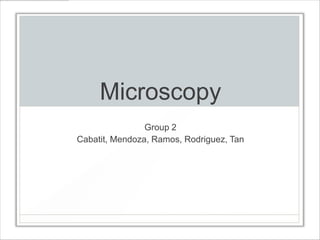
Microscopy
- 1. Microscopy Group 2 Cabatit, Mendoza, Ramos, Rodriguez, Tan
- 2. Compound Light Microscope • A device that transmits light through several lenses to produce an enlarged image of a microscopic specimen. • Modern compound light microscopes, under optimal conditions, can magnify an object from 1000X to 2000X (times) the specimens original diameter.
- 4. Bright Field Microscopy • Simplest optical microscopy illumination technique • Uses visible light as source of illumination • > the shorter the wavelength, the greater the resolution (blue is the best) • Contrast comes from absorbance of light in the sample, or from staining. • When the diaphragm is wide open the image is brighter and contrast is low.
- 5. Bright Field Microscopy • Sources of illumination: Lamp on the base • Types of image produced: Relatively large internal structures and outline can be seen • Total Magnification: (if 10x ocular magnification is used) Range: 10x-1000x • Resolution: Up to 200nm (white light)
- 9. Dark Field Microscopy • Type of microscopy which is the exact opposite of a bright field microscope • Dark background/field with the specimen being the only one illuminated. • Used in observing unstained specimens • Most microscopes have the potential to do dark field microscopy such as compound or stereomicroscopes.
- 10. Dark Field Microscopy • Light source: Light bulb from a microscope • Condenser type: Specialized to block most light from the source; contains an annular/patch stop which disperses the light in various directions, resulting to a ―cone of light‖ • Image formed: Dark background with illuminated specimen; may be inverted or not depending on microscope used
- 11. Dark Field Microscopy • Total Magnification: Can range from those of compound microscopes (10x to 1000x)
- 12. Pros and Cons of Dark Field Microscopy Advantages Disadvantages • Used to view unstained • Can be inaccurate specimens more clearly. compared to other methods. • Special care if more needed • Can be used to study for this type of microscopy various live to prevent aberrations. bacteria, protists, algae, fu ngi, and many other • Needs intense amount of cultures. light which can hurt the eyes and cause glare. • Can examine the external • Air bubbles in the slide can of the specimen with detail cause problems.
- 16. Phase-contrast microscope • Type of light microscope • Enhances contrast in micrographs by converting phase shifts of light waves into brightness • Offers more contrast than brightfield microscopy • Does not require the use of staining procedures which usually kill cells • Especially useful for examining living, unpigmented cells
- 17. Source of illumination • Visible light from an illuminator TOTAL MAGNIFICATION • Phase contrast objective lenses (Nikon) come in 4x, 10x, 20x, and 40x powers, so the total magnification for phase contrast microscopes range from 40x to 400x
- 18. Principle • Differences in density (Campbell et. al., 1999) or refractive index (Tortora et. al., 2007) within the specimen or cell causes light waves to be diffracted at different degrees • Diffraction of light waves implies a change in the phase of their wavelength
- 19. Principle • A unique part of the phase-contrast microscope, called the phase-plate, amplifies this change in phase to one-half wavelength • When both the direct (undiffracted) and reflected (diffracted) types of light waves converge at the ocular lens, constructive and destructive interference occurs
- 20. Principle
- 21. Principle
- 22. Principle • Constructive interference corresponds to bright spots in the field of view • Destructive interference corresponds to dark spots
- 23. Type of image produced • The end result is a magnified and highly contrasted view of a living, unstained, normally transparent specimen
- 27. Scanning Electron Microscope • Illumination: electrons • Magnification: ~100,000x • How it works: Detect electrons back-scattered by the sample. • Image: Monotone (but may be color enhanced), 3- D surface of specimen
- 28. • Magnetic lens— focuses electron beam • Scanning coils—for systematic scanning (left to right, then down) • Backscattered Electron Detector– detects electrons that bounced off the film • Secondary Electron Detector– detects electrons emitted by Source: http://www.purdue.edu/rem/rs/graphics/sem2.gif
- 29. Pros Cons • High magnification • Needs specimen to be in vacuum • High resolution • Needs living cells and tissues • Shows the surface of specimen and whole, soft-bodied organisms to be treated, usu. coated w/ gold film • No color • Cannot examine live specimen • Really. Big. And Expensive. Equipment.
- 30. Transmission Electron Microscope • Illumination: electrons • Magnification: ~100,000x • How it works: Detect electrons scattered as they move through the sample. • Image: Monotone (but may be color enhanced), 2- D structure of specimen
- 32. Pros Cons • High magnification • Needs specimen to be in vacuum • High resolution • Needs specimen to be covered • Shows small structures that in gold film cannot be seen under light microscopes • Specimen <100nm thick (obviously cannot observe live specimen) • No color • Really. Big. And. Expensive. Equipment
- 34. End
Editor's Notes
- Hence, best suited to viewing stained or naturally pigmented specimens such as stained prepared slides of tissue sections or living photosynthetic organisms
